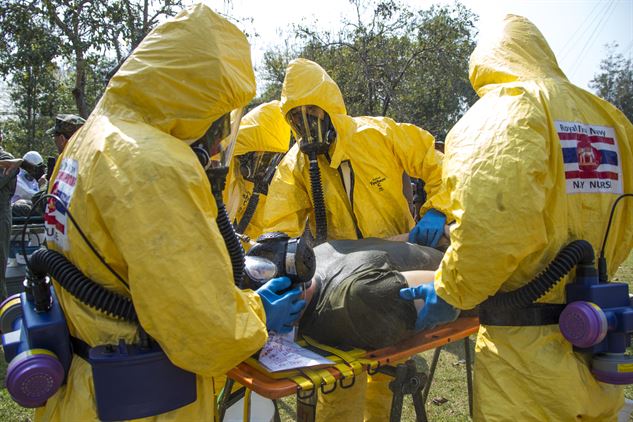by Jordan Street and Murray Ackman
The evidence that mainstream counter-terror strategies need a rethink is crystal clear. Will 2018 be the year that decision-makers begin taking it seriously? The failure of current counter-terror strategies—in countries like Afghanistan, Egypt, Somalia, Yemen, and Syria—is painfully obvious. Reducing the global threat of terrorism will not happen with a doubling down on past approaches, but instead requires a strategic focus on resolving conflict by addressing its causes.
Terrorism has spread into more countries since the “war on terror” began. Although there has been a decrease in the overall deaths from terrorism, evidence shows that for the first time ever, two out of every three countries—106 out of 163 in the Institute of Economics and Peace’s Global Terrorism Index—experienced a terror attack in 2016.
Although terror attacks in Britain, Europe, and the US have dominated news cycles and political debates worldwide, three-quarters of terror attacks occur in just five countries: Afghanistan, Iraq, Nigeria, Pakistan, and Syria. The Global Terrorism Index shows that countries in the Global South remain on the sharpest end of the terror threat with a 67% increase in attacks in 2016 and a nearly sixfold increase in deaths between 2014 and 2016.
There are countless examples of how international counter-terror and stabilization strategies are exacerbating the drivers of conflict.
The US and UK continue to arm—and provide diplomatic cover for—the Saudi-led coalition in its bid to reinstate the government of Yemen, precipitating a devastating humanitarian crisis and further destabilizing the wider Gulf region. Early in 2016, we reported on how the Western-backed Saudi intervention was exacerbating the conflict and enabling groups like al-Qaeda and the Islamic State (ISIS or IS) to transform and grow within Yemen. Yet the indiscriminate aerial bombardment and blockade of Yemen drag on.
Western actors continue to act based on superficial understanding and continue to rely on untrustworthy partners. Last August one side of a clan conflict in Somalia seemingly manipulated U.S. forces to target the other side under the pretext that it was al-Shabaab. This resulted in a disastrous counter-terrorism operation that killed many civilians and, in turn, appears to have motivated the car bomb attack in Mogadishu in October that killed over 500 people.
The physical elimination of terrorist fighters remains front and center in many counter-terror strategies, despite the poor track record of military action in bringing conflicts and violent movements to an end. In places supposedly cleared of IS in Iraq and Syria, the lack of reconstruction initiatives is offering fertile ground for violent actors to regroup within a society long brutalized and now abandoned. A comprehensive strategy to address the conditions that gave rise to the likes of al-Qaeda, IS, and Jabhat al-Nusra and its successors is still glaringly absent.
Fear of blowback does not appear to alter policies. Huge quantities of Western arms have leaked into the hands of IS, al-Shabaab, armed groups in Yemen, and al-Qaeda. Yet foreign governments continue to pour weapons into volatile regions to back unpredictable allies in dangerous ways. Currently American weapons are being channelled into countries like Lebanon, despite its obvious vulnerability to future instability that could easily divert them into the wrong hands.
It is high time to consign such counter-productive international counter-terror approaches to the dustbin of history. Decision-makers and leaders need a new game plan to halt the upward trend in violence and stop making the same strategic mistakes. Ultimately, the current strategy benefits only arms companies, politicians who posture as tough on terrorists, and the violent groups themselves.
Research shows that in almost every case, the prevalence of terror attacks is closely tied to an increase in political unrest and conflict, yet Western actors continue to embrace allies who are part of the problem. In 2016, the Global Terrorism Index shows that 99% of all deaths from violent attacks associated with terror and 96% of all attacks globally occurred in countries that were both involved in an armed conflict and had high levels of political terror.
A recent study by the United Nations Development Program shows that counter-terrorism strategies and overzealous militarized responses have led to distrust in government institutions and alienation in segments of the population. In interviews with over 500 former violent group members in Kenya, Nigeria, Somalia, and Sudan, 71% of respondents affirmed that “government action” was the tipping point for them to join a violent group.
If international leaders are genuinely interested in reducing the threat of terrorism around the world, their strategies should focus on resolving conflict by addressing its causes. Successful counter-terror strategies would focus on preventing abuses by security forces, challenging and improving weak or corrupt governance, supporting equitable access to services, protecting and empowering civil society, and investing in peace and reconstruction processes that accord conflict-affected people and societies the leading role.
When counter-terrorism approaches are replaced by more comprehensive peace strategies, real results can be achieved. In Garissa County in Kenya, which has suffered terribly from terror attacks, a 2017 study highlighted the positive impact of a new strategy that tackled abuses by security forces and restored trust and partnership with the population, leading to a marked decline in attacks and improved perceptions of security.
Becoming secure in the West paradoxically depends on focusing strategy on the problems conflict-affected people see as most important. Western security cannot be achieved at the expense of others. Unless policymakers in the West reframe strategy based on this understanding, as Global Terrorism Index data shows, communities living in conflict-affected and fragile countries will continue to suffer the most—but the blowback will increasingly impact the world’s most economically advanced countries.
Casualties from terror attacks have risen more than seven-fold since the “war on terror” began. The mounting pressure on leaders to act fast and achieve results makes it harder to adopt the smart, long-term solutions the problem requires. To tackle the issue of terrorism in a serious way, leaders need to reflect on the reasons for failure and forge better foreign and domestic policies. If not, the threat of terrorism at home and abroad will persist and grow in coming years.
Jordan Street is policy coordinator at Saferworld. Murray Ackman is a research associate at the Institute for Economics and Peace (IEP). Photo: Simulated chemical terrorist attack in Thailand (U.S. Marine Corps photo by Cpl. James R. Smith).






The words “terrorist” and “terrorism” have lost all semblance of meaning. The “the unlawful use of violence and intimidation, especially against civilians, in the pursuit of political aims” as a definition does not apply to:
>Afghanis who are displeased that the US invaded, overturned their government and shot them on sight. If it were the French against Germany they’d be “freedom-fighters.”
>Similarly Somalis who have been attacked by Americans for years are not terrorists, nor are the Yemenis engaged in a civil war, nor the Islamic radical allies of the US trying (unsuccessfully) to overthrow the Syrian government. Or is the Syria government a terrorist??
>Lately any body of people actively opposed to US war policy are “terrorists.” (They have been promoted from “militants” and “dissidents.”)
What has happened, and Somalia is a good example, is that people in far-away countries who are fighting for their rights (as Americans once did) then find that the US is attacking them for political purposes so they say Oh yes, we’re allied with _____ (ISIS, al Qaeda etc) to encourage assistance from anyone who will help them, and also to gain recruits.
So “rethinking counter-terror strategies” has no meaning without a proper definition of terms. By the way, when the “war on terror” first started there were some people who believed that since terrorism is a civilian crime it ought to be addressed by people involved in intelligence and policing, not by military means. (I forget who they were, I think maybe Rumsfeld and/or Powell.) Of course history (and Rand studies) have shown that military activities only increase “terrorism” but that seems to be a US objective so there you go.
Thanks for that interesting post , the respectable author of the post , is more than some extent , right simply . Yet , he has ignored one of the major reasons , for why governments are fighting so terror . It is simply the public opinion which is at stake here . Many times , public opinion is shocked , and demands right here , right now , action . Action , that is to say , aggressive and firm , surly not vague and long term investments somewhere offshore . That is how , a vicious circle is formed :
the elected government , wants to satisfy public opinion , simply for the coming next tenure or election drawing near . So , if the author of the post , wants to start somewhere ( effectively so ) he would better do it , by starting with public opinion ( hell of a mission I must admit ) .
Thanks